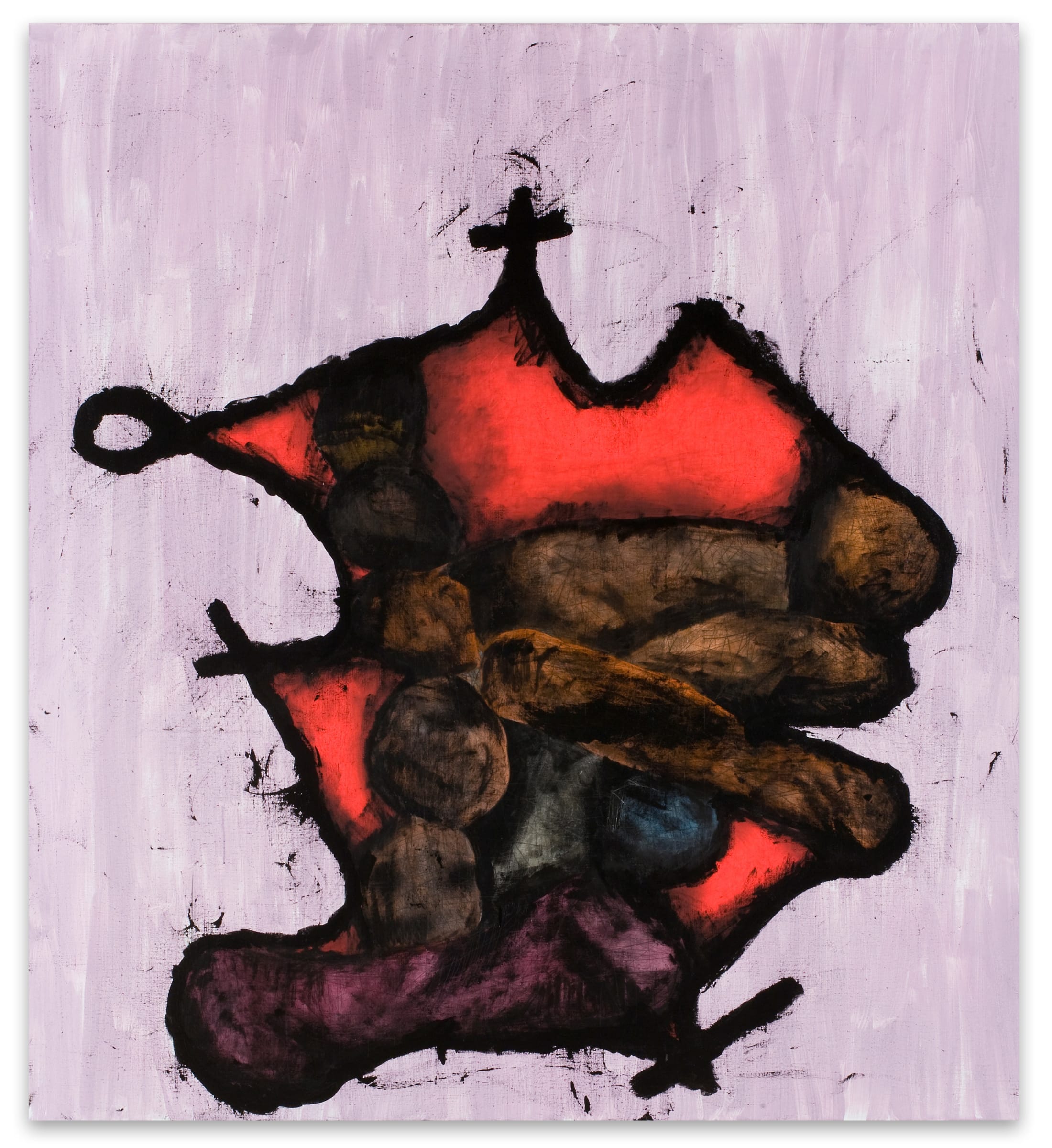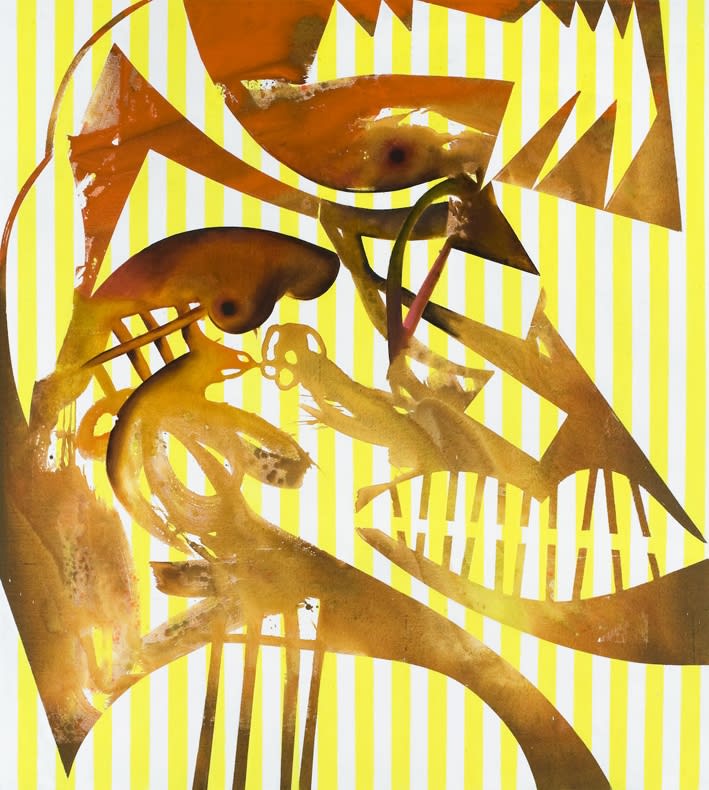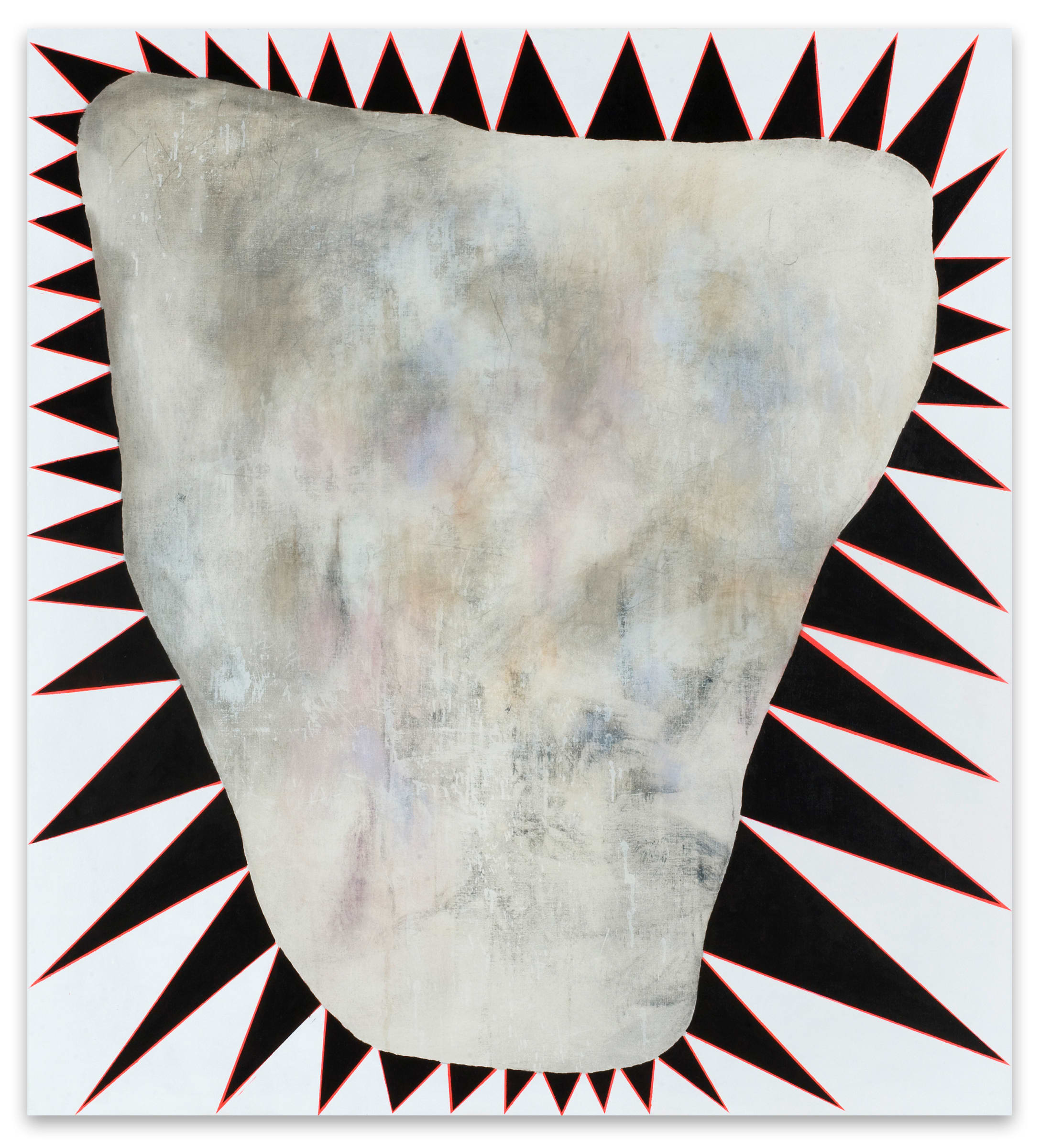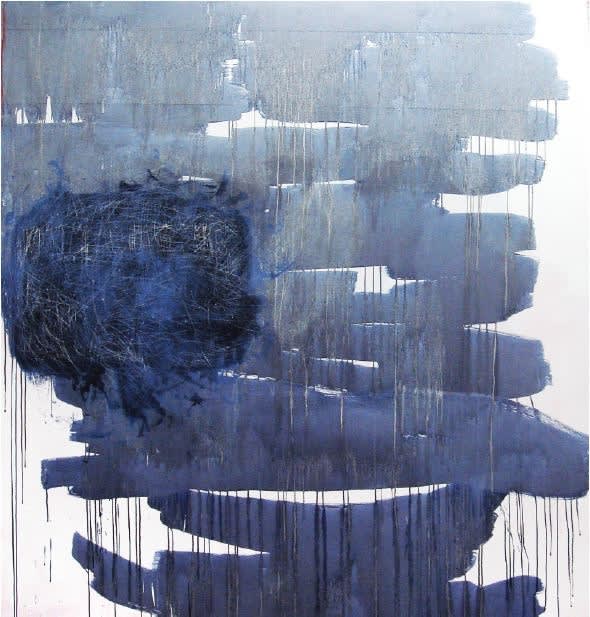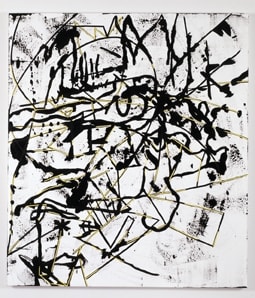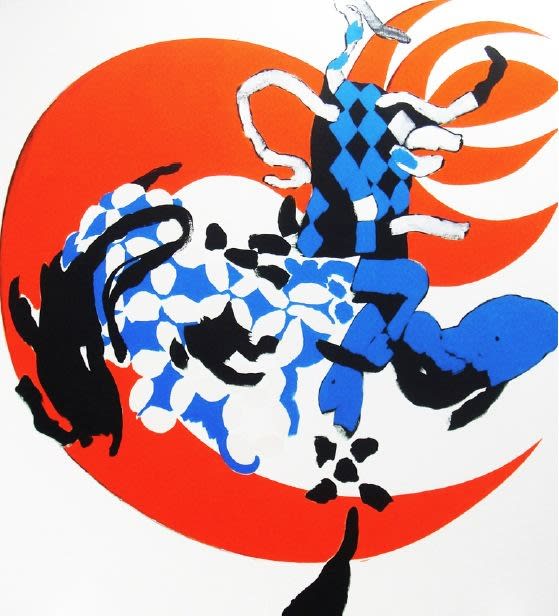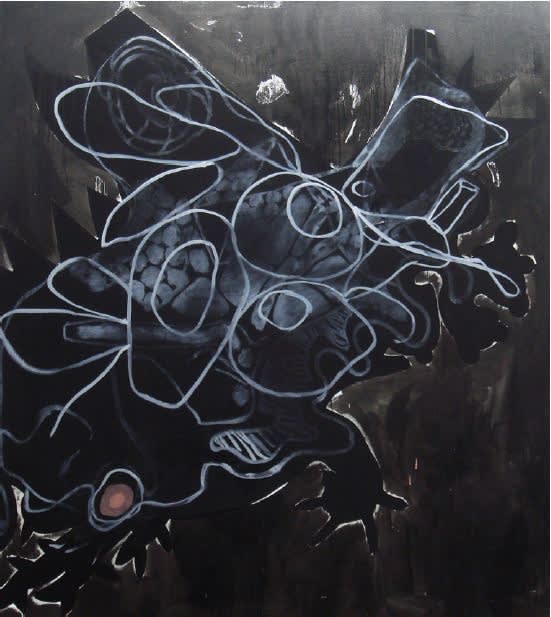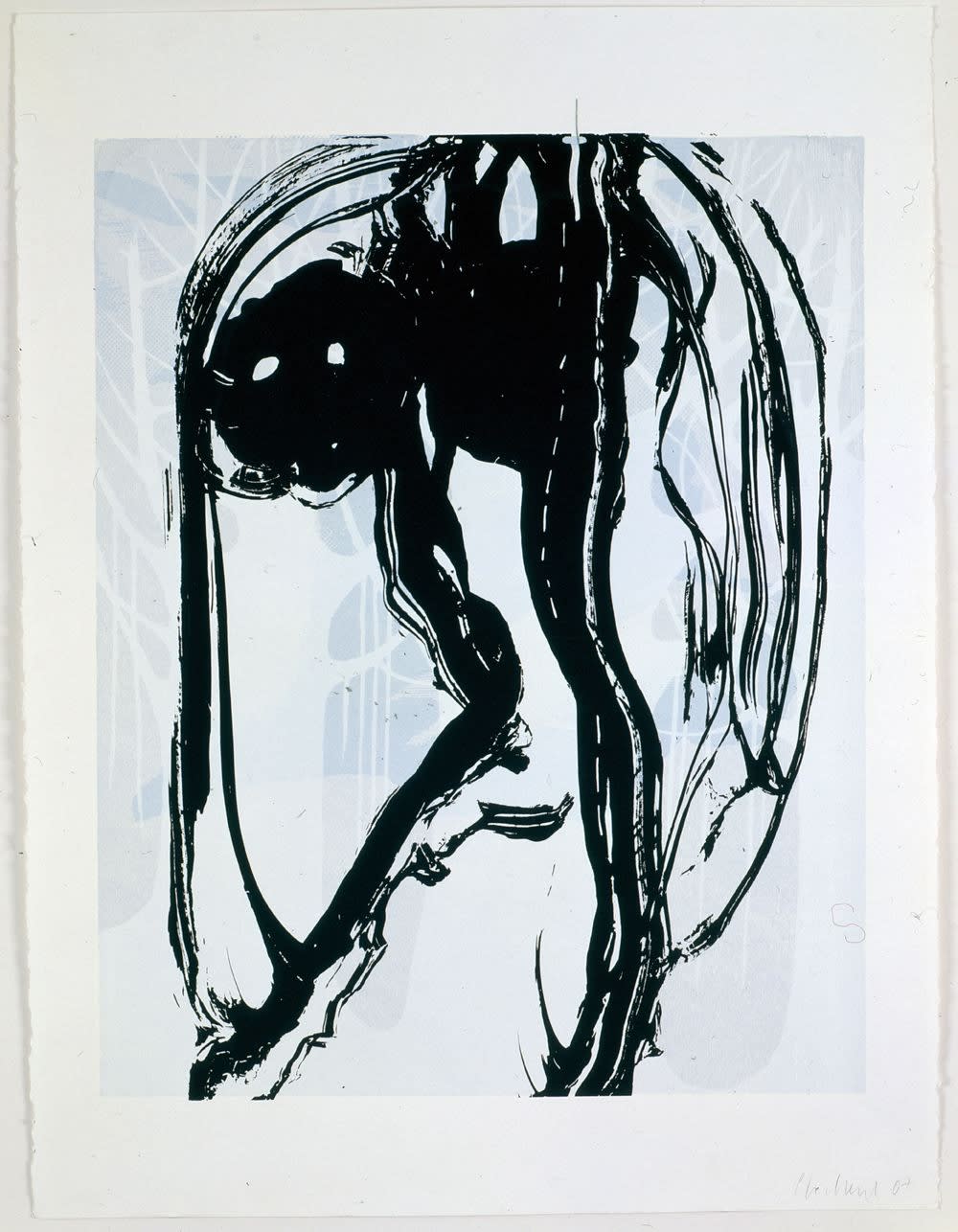Charline von Heyl
The exhibition presents a series of large paintings and new mixed media works on paper. While the paintings exu- berate a new interest in iconic presence, the works on paper are the result of the artist’s recent exploration of new techniques, such as combining printing, drawing and collage processes. The unframed, clustered hanging of these works evoke the informal situation of the artist’s studio, where they developed in a climate of experimentation and cross-referencing.
Born in Germany in 1960, von Heyl studied painting with Jörg Immendorff in Hamburg and Fritz Schwegler in Düs- seldorf. She developed her independent artistic voice within the context of a renaissance of painting, which saw the rift between the ironic political work of the group of painters around Martin Kippenberger in Cologne, the emotionally expressive Junge Wilde group in Berlin and the calculated geometric abstractions of neo-geo art emerging from the USA. While her paintings have the dynamic energy of the German painting schools, they disable any form of literal interpretation. Von Heyl’s work is marked by an abstract vocabulary based on the dynamic interplay between expressive gestures and static shapes. In her practice, she often begins with what she calls ‘a skeleton of gestures’, to which she gradually adds the ‘flesh of colour’. While the tension between line and colour is clearly visible in a pain- ting like Dialogue Solitaire, this process is inverted in Phoenix, which is marked by one of the artist’s recurring formal concerns: the dynamic dialogue between positive and negative space. Reminiscent of cut-out forms, works such as Kastle Keep play with the idea of presence and the equally powerful lack of it, the void. It is the dynamic tension bet- ween plenitude and emptiness, which makes also works such as Voyage Out so compelling.
Charline von Heyl explores a visual experience by stepping into the gap between language and body, knowing and not-knowing, the self and the other. Through their denial of readability, her paintings can be interpreted as visions of this ‘non-knowledge’, of this other. They push us to leave the comfortable path of cognitive knowledge, logic and reason and invite us to explore the tension between the desire to ‘see’ the familiar and the denial of it thereof. The artist’s stubborn refusal to provide her audience with a signature product is a political gesture at a time in which the art market dictates our likes and dislikes, our tastes and values. With every painting von Heyl embarks on a fresh journey. She once described the crucial point at which the slightest alteration to a painting can either defeat or sub- limate it as a ‘suicidal moment’. This feeling of challenge or even risk is part of an emotional intensity in her practice as a painter, which according to von Heyl is always based on the paradox between sacrifice and egotism. While she describes herself as a formalist, her works are imbued with emotions. Personal feelings, however, are only the me- ans to an end, the painting. In Heyl’s own words, she ‘feeds them to the vampires, the paintings’. For her the desire to freely create something new and unexpected when faced with a white canvas has always been the essential drive for her artistic practice. This exhibition invites the viewer to partake in this intimate yet open process.
-
 Charline von HeylMelancolia, 2008Acrylic, oil and charcoal on linenSigned, titled, dated on verso218.4 x 208.3 cm / 86 x 82 inches
Charline von HeylMelancolia, 2008Acrylic, oil and charcoal on linenSigned, titled, dated on verso218.4 x 208.3 cm / 86 x 82 inches -
 Charline von HeylIgitur, 2008Acrylic on linen208.3 x 188 x 3.8 cm / 82 x 74 x 1.5 inches
Charline von HeylIgitur, 2008Acrylic on linen208.3 x 188 x 3.8 cm / 82 x 74 x 1.5 inches -
 Charline von HeylOrpheus, 2008Acrylic on linen208.3 x 188 x 3.8 cm / 82 x 74 x 1.5 inches
Charline von HeylOrpheus, 2008Acrylic on linen208.3 x 188 x 3.8 cm / 82 x 74 x 1.5 inches -
 Charline von HeylP., 2008Acrylic and crayons on linen208.3 x 188 x 3.8 cm / 82 x 74 x 1.5 inches
Charline von HeylP., 2008Acrylic and crayons on linen208.3 x 188 x 3.8 cm / 82 x 74 x 1.5 inches -
 Charline von HeylAlastor, 2008Acrylic on linen208.3 x 198.1 x 3.8 cm / 82 x 78 x 1.5 inches
Charline von HeylAlastor, 2008Acrylic on linen208.3 x 198.1 x 3.8 cm / 82 x 78 x 1.5 inches -
 Charline von HeylBlue eye, 2008Acrylic and charcoal on linenSigned, titled, dated on verso208.3 x 198.1 cm / 82 x 78 inches
Charline von HeylBlue eye, 2008Acrylic and charcoal on linenSigned, titled, dated on verso208.3 x 198.1 cm / 82 x 78 inches -
 Charline von HeylDialogue Solitaire, 2008Acrylic on linenSigned, titled, dated on verso208.3 x 182.9 cm / 82 x 72 inches
Charline von HeylDialogue Solitaire, 2008Acrylic on linenSigned, titled, dated on verso208.3 x 182.9 cm / 82 x 72 inches -
 Charline von HeylPhoenix, 2008Acrylic on linenSigned, titled, dated on verso208.3 x 188 cm / 82 x 74 inches
Charline von HeylPhoenix, 2008Acrylic on linenSigned, titled, dated on verso208.3 x 188 cm / 82 x 74 inches -
 Charline von HeylNuit de Paris, 2008Acrylic, oil and charcoal on linenSigned, titled, dated on verso208.3 x 188 cm / 82 x 74 inches
Charline von HeylNuit de Paris, 2008Acrylic, oil and charcoal on linenSigned, titled, dated on verso208.3 x 188 cm / 82 x 74 inches -
 Charline von HeylVoyage, 2008Acrylic and charcoal on linenSigned, titled, dated on verso208.3 x 198.1 cm / 82 x 78 inches
Charline von HeylVoyage, 2008Acrylic and charcoal on linenSigned, titled, dated on verso208.3 x 198.1 cm / 82 x 78 inches -
 Charline von HeylUntitled, 2008Mixed media on paper76.5 x 56.2 cm / 30 1/8 x 22 1/8 inches
Charline von HeylUntitled, 2008Mixed media on paper76.5 x 56.2 cm / 30 1/8 x 22 1/8 inches

